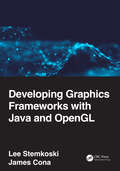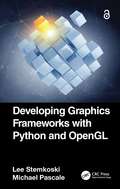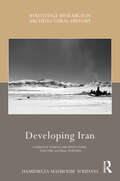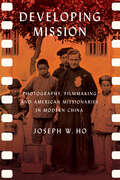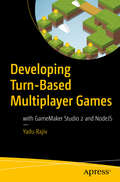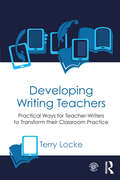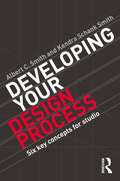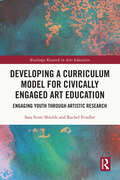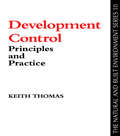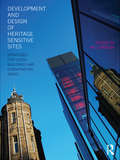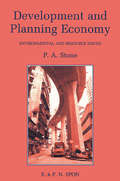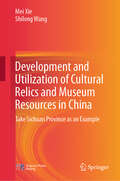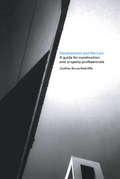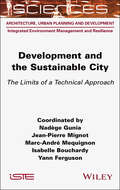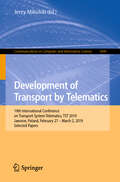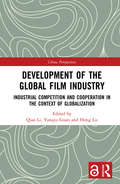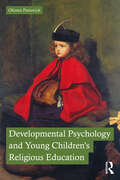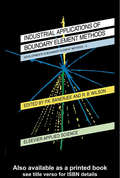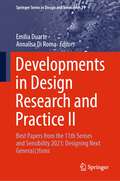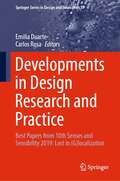- Table View
- List View
Developing Graphics Frameworks with Java and OpenGL
by Lee Stemkoski James ConaDeveloping Graphics Frameworks with Java and OpenGL shows you how to create software for rendering complete three-dimensional (3D) scenes. The book explains the foundational theoretical concepts as well as the practical programming techniques that will enable you to create your own animated and interactive computer-generated worlds. You will learn how to combine the power of OpenGL, the most widely adopted cross-platform application programming interface (API) for graphics processing unit (GPU) programming, with the accessibility and versatility of the Java programming language. Topics in this book include generating geometric shapes, transforming objects with matrices, applying image-based textures to surfaces, and lighting a scene. Advanced sections explain how to implement procedurally generated textures, postprocessing effects, and shadow mapping. In addition to the sophisticated graphics framework discussed throughout the book, you will gain a foundational knowledge that will allow you to adapt and extend that framework, leading to even more spectacular graphical results. Author bios Lee Stemkoski is a professor of mathematics and computer science. He earned his Ph.D. in mathematics from Dartmouth College in 2006 and has been teaching at the college level since. His specialties are computer graphics, video game development, and virtual and augmented reality programming. James Cona is an up-and-coming software engineer who studied computer science at Adelphi University. Some of his specific interests include music, video game programming, 3D graphics, artificial intelligence, and clear and efficient software development in general.
Developing Graphics Frameworks with Python and OpenGL
by Lee Stemkoski Michael PascaleDeveloping Graphics Frameworks with Python and OpenGL shows you how to create software for rendering complete three-dimensional scenes. The authors explain the foundational theoretical concepts as well as the practical programming techniques that will enable you to create your own animated and interactive computer-generated worlds. You will learn how to combine the power of OpenGL, the most widely adopted cross-platform API for GPU programming, with the accessibility and versatility of the Python programming language. Topics you will explore include generating geometric shapes, transforming objects with matrices, applying image-based textures to surfaces, and lighting your scene. Advanced sections explain how to implement procedurally generated textures, postprocessing effects, and shadow mapping. In addition to the sophisticated graphics framework you will develop throughout this book, with the foundational knowledge you will gain, you will be able to adapt and extend the framework to achieve even more spectacular graphical results.
Developing Iran: Company Towns, Architecture, and the Global Powers (Routledge Research in Architectural History)
by Hamidreza Mahboubi SoufianiThis book examines the emergence of modern company towns in Iran by delineating the architectural, political, and industrial histories of three distinct resource-based ‘company town’ projects built in association with the ‘Big Three’ powers of World War II. The book’s narrative builds upon a tripartite research design that chronologically traces the formation and development of the oil, steel, and copper industries, respectively favoured by Great Britain, the Soviet Union, and the United States in this part of the world. By applying three sets of comparative studies, the book provides critical vantage points to three different ideological design paradigms: postcolonial regionalism, socialist universalism, and rationalist modern nation building. From a global political context, the book contributes to the disclosure of new information about the geopolitical confrontation of these three nations in the Global South to increase their sphere of influence after the Second World War. Furthermore, it demonstrates how postwar architectural modernism was adopted by each power and adapted to their ideological mind frame to fulfil distinct social, cultural, political, and economic targets. This book examines multiple interconnections between architecture, politics, and industrial development by adopting a transdisciplinary approach based on comprehensive fieldwork, site surveys, and the analysis of original multilingual documents. As such, it will be of interest to researchers and students of architecture, history, international relations, and Middle Eastern studies.
Developing Kaggle Notebooks: Pave your way to becoming a Kaggle Notebooks Grandmaster
by Gabriel PredaPrinted in Color Develop an array of effective strategies and blueprints to approach any new data analysis on the Kaggle platform and create Notebooks with substance, style and impact Leverage the power of Generative AI with Kaggle Models Purchase of the print or Kindle book includes a free PDF eBookKey FeaturesMaster the basics of data ingestion, cleaning, exploration, and prepare to build baseline modelsWork robustly with any type, modality, and size of data, be it tabular, text, image, video, or soundImprove the style and readability of your Notebooks, making them more impactful and compellingBook DescriptionDeveloping Kaggle Notebooks introduces you to data analysis, with a focus on using Kaggle Notebooks to simultaneously achieve mastery in this fi eld and rise to the top of the Kaggle Notebooks tier. The book is structured as a sevenstep data analysis journey, exploring the features available in Kaggle Notebooks alongside various data analysis techniques. For each topic, we provide one or more notebooks, developing reusable analysis components through Kaggle's Utility Scripts feature, introduced progressively, initially as part of a notebook, and later extracted for use across future notebooks to enhance code reusability on Kaggle. It aims to make the notebooks' code more structured, easy to maintain, and readable. Although the focus of this book is on data analytics, some examples will guide you in preparing a complete machine learning pipeline using Kaggle Notebooks. Starting from initial data ingestion and data quality assessment, you'll move on to preliminary data analysis, advanced data exploration, feature qualifi cation to build a model baseline, and feature engineering. You'll also delve into hyperparameter tuning to iteratively refi ne your model and prepare for submission in Kaggle competitions. Additionally, the book touches on developing notebooks that leverage the power of generative AI using Kaggle Models.What you will learnApproach a dataset or competition to perform data analysis via a notebookLearn data ingestion and address issues arising with the ingested dataStructure your code using reusable componentsAnalyze in depth both small and large datasets of various typesDistinguish yourself from the crowd with the content of your analysisEnhance your notebook style with a color scheme and other visual effectsCaptivate your audience with data and compelling storytelling techniquesWho this book is forThis book is suitable for a wide audience with a keen interest in data science and machine learning, looking to use Kaggle Notebooks to improve their skills and rise in the Kaggle Notebooks ranks. This book caters to: Beginners on Kaggle from any background Seasoned contributors who want to build various skills like ingestion, preparation, exploration, and visualization Expert contributors who want to learn from the Grandmasters to rise into the upper Kaggle rankings Professionals who already use Kaggle for learning and competing
Developing Mission: Photography, Filmmaking, and American Missionaries in Modern China (The United States in the World)
by Joseph W. HoIn Developing Mission, Joseph W. Ho offers a transnational cultural history of US and Chinese communities framed by missionary lenses through time and space—tracing the lives and afterlives of images, cameras, and visual imaginations from before the Second Sino-Japanese War through the first years of the People's Republic of China. When American Protestant and Catholic missionaries entered interwar China, they did so with cameras in hand. Missions principally aimed at the conversion of souls and the modernization of East Asia, became, by virtue of the still and moving images recorded, quasi-anthropological ventures that shaped popular understandings of and formal foreign policy toward China. Portable photographic technologies changed the very nature of missionary experience, while images that missionaries circulated between China and the United States affected cross-cultural encounters in times of peace and war. Ho illuminates the centrality of visual practices in the American missionary enterprise in modern China, even as intersecting modernities and changing Sino-US relations radically transformed lives behind and in front of those lenses. In doing so, Developing Mission reconstructs the almost-lost histories of transnational image makers, subjects, and viewers across twentieth-century China and the United States.
Developing Story Ideas: The Power and Purpose of Storytelling
by Michael RabigerThe vast majority of screenplay and writing books that focus on story development have little to say about the initial concept that inspired the piece. Developing Story Ideas: The Power and Purpose of Storytelling, Third Edition provides writers with ideational tools and resources to generate a wide variety of stories in a broad range of forms. Celebrated filmmaker and author Michael Rabiger demonstrates how to observe situations and themes in the writer's own life experience, and use these as the basis for original storytelling. This new edition has been updated with chapters on adaptation, improvisation, and cast collaboration's roles in story construction, as well as a companion website featuring further projects, class assignments, instructor resources, and more. Gain the practical tools and resources you need to spark your creativity and generate a wide variety of stories in a broad range of forms, including screenplays, documentaries, novels, short stories, and plays Through hands-on, step-by-step exercises and group and individual assignments, learn to use situations and themes from your own life experience, dreams, myth, and the news as the basis for character-driven storytelling; harness methods of screenplay format, dialogue, plot structure, and character development that will allow your stories to reach their fullest potential
Developing Story Ideas: The Power and Purpose of Storytelling
by Michael RabigerThe vast majority of screenplay and writing books that focus on story development have little to say about the initial concept that inspired the piece. Developing Story Ideas: The Power and Purpose of Storytelling, Third Edition provides writers with ideational tools and resources to generate a wide variety of stories in a broad range of forms. Celebrated filmmaker and author Michael Rabiger demonstrates how to observe situations and themes in the writer’s own life experience, and use these as the basis for original storytelling. This new edition has been updated with chapters on adaptation, improvisation, and cast collaboration’s roles in story construction, as well as a companion website featuring further projects, class assignments, instructor resources, and more. Gain the practical tools and resources you need to spark your creativity and generate a wide variety of stories in a broad range of forms, including screenplays, documentaries, novels, short stories, and plays Through hands-on, step-by-step exercises and group and individual assignments, learn to use situations and themes from your own life experience, dreams, myth, and the news as the basis for character-driven storytelling; harness methods of screenplay format, dialogue, plot structure, and character development that will allow your stories to reach their fullest potential
Developing Turn-Based Multiplayer Games: with GameMaker Studio 2 and NodeJS
by Yadu RajivCreate your first turn-based multiplayer game using GameMaker Studio 2’s built-in networking functions as well as using a simple NodeJS server. This book introduces you to the complexities of network programming and communication, where the focus will be on building the game from the ground up. You will start with a brief introduction to GameMaker Studio 2 and GML coding before diving into the essential principles of game design. Following this, you will go through an introductory section on NodeJS where you will learn how to create a server and send and receive data from it as well as integrating it with GameMaker Studio. You will then apply multiplayer gaming logic to your server and unlock multiplayer game features such as locating a player, syncing their data, and recording their session. What You Will LearnDiscover the architecture of GameMaker Studio 2 Add new features to your game with NodeJS modulesIntegrate GameMaker Studio 2 with NodeJS Master GameMaker Studio 2's built-in networking functionsWho This Book Is ForGameMaker Studio users who want to understand how the networking components of GMS 2 work. Basic JavaScript knowledge is required.
Developing Visual Arts Education in the United States
by Mary Ann StankiewiczThis bookexamines how Massachusetts Normal Art School became the alma mater par excellencefor generations of art educators, designers, and artists. The founding myth ofAmerican art education is the story of Walter Smith, the school's firstprincipal. This historical case study argues that Smith's students formed theprofessional network to disperse art education across the United States,establishing college art departments and supervising school art for industrialcities. As administrative progressives they created institutions and set normsfor the growing field of art education. Nineteenth-century artists argued thatanyone could learn to draw; by the 1920s, every child was an artist whosecreativity waited to be awakened. Arguments for systematic art instructionunder careful direction gave way to charismatic artist-teachers who sought torelease artistic spirits. The task for art education had been redefined interms of living the good life within a consumer culture of work and leisure.
Developing Writing Teachers: Practical Ways for Teacher-Writers to Transform their Classroom Practice
by Terry LockeThe premise of Developing Writing Teachers is this: When teachers of writing identify as writers, it adds a special dimension to their writing pedagogy. Practical and accessible while drawing on a range of relevant research and theory, this text is distinguished by its dual focus—on teachers as writers and the teaching of writing. Part I addresses the question, What does it take for a teacher of writing to develop an identity as writer? Using case studies and teacher narratives, it guides readers to an understanding of the current status of writing as the 21st century unfolds, the role of expressive writing in developing a writing identity, the relationship of writing to genre and rhetoric, writing and professional identity, and writing as design. Part II focuses on pedagogical practice and helping writer-teachers develop a toolkit to take into their classrooms. Coverage includes building a community of writing practice; the nature of writing as process; the place of grammar; the role of information, communication and representational technologies; and how assessment, properly used, can help develop writing. Ideal for for pre-service and in-service courses on the teaching of writing, the Companion Website provides aadditional readings/documents; PowerPoint presentations; assessment resources; and lesson and unit plans and planning guides.
Developing Your Design Process: Six Key Concepts for Studio
by Albert C. Smith Kendra Schank SmithDeveloping Your Design Process is your primary source for acquiring knowledge of how and why you design. It will help you understand how architects think as well as learn why you should educate yourself about design culture. You'll explore the spark of imagination that leads to a strong concept, realize the importance of sketching and rough drafts, focus your original concept to make your abstract idea visible, and finally step away for a moment to critically question your concept by identifying its strengths and weaknesses. You'll also be introduced to the language of design, architectural terminology, historic precedents, and designers, in addition to the why, what, and how of the design process. The book is illustrated throughout with international examples of work by professionals and students in the discipline of architecture, and other related design professions.
Developing a Curriculum Model for Civically Engaged Art Education: Engaging Youth through Artistic Research (Routledge Research in Arts Education)
by Sara Scott Shields Rachel FendlerThis volume explores art as a means of engendering youth civic engagement and draws on research conducted with young people in the United States to develop a unique curriculum model for civically engaged art education (CEAE). Combining concepts from civics and arts education, chapters posit that artistic thinking, making, and acting form the basis for creative research into social and political issues which affect young people and are key to promoting civic participation. Focusing on critical, creative, and dynamic forms of youth cultural production inspired by local people, places, and events, the text demonstrates how educators’ curricular choices can engage students in researching social movements and arts-based activism. The authors draw from well-established areas such as arts-based research, civic engagement, and maker-centered learning to present their educational model through illustrative examples. Offering a timely consideration of the relationship between art education and civics education, this book will appeal to scholars and students of the sociology of education, as well as arts and teacher research, and pre-service teacher education.
Development Control (Natural and Built Environment Series #Vol. 11)
by Keith ThomasDevelopment Control" is a comprehensive introductory text for students of planning and related subjects. Drawing widely on the literature - the approach and treatment are very much geared to the needs of students on courses, rather than focusing on practical and "how-to-do-it" issues. It should be of interest to students in schools of planning, the built environment, estate management, land economy and other related subjects.
Development Policy and Planning: An Introduction to Models and Techniques
by Anis Chowdhury Colin KirkpatrickReorientation from economic controls to a market-based approach led to significant changes in the economic policy of developing countries in the 1980s. Yet, with governments continuing to exercise economic management to accelerate growth beyond that achieved by market forces, techniques and models of development planning are still an integral feature of development policy management. Development Policy and Planning provides a non-technical explanation of the main techniques and models used for economic policy formulation. Each technique is illustrated in application through practical examples.
Development and Design of Heritage Sensitive Sites: Strategies for Listed Buildings and Conservation Areas
by Kenneth WilliamsonThis is the first book to provide readers with the skills to assess development potential from a holistic standpoint. Until now, architectural books on conservation matters have focused on preservation at a strategic level and restoration at a technical level. This book offers the architect, developer or planner the rules and tools needed to gauge development prospects in an objective and comprehensive manner. Written by an expert in the field it provides the reader with: the latest legislation relating to heritage in the UK insight into local planning authorities and government advisory boards basic strategies for approaching developments an understanding of the options available for developing a heritage site illustrative case studies to highlight strategy successes. This book is a one-stop-shop for any professional or student working in, or learning about, development in heritage environments.
Development and Planning Economy: Environmental and resource issues
by P.A. StoneThis book describes in detail how the property market operates, giving a clear picture of the economics of development and the way which development issues are defined by (and in their turn have an effect on) community and individual needs. By describing how the market works and explaining the factors which need to be analysed, the author aims to improve decision-making techniques and machinery.
Development and Utilization of Cultural Relics and Museum Resources in China: Take Sichuan Province as an Example
by Shilong Wang Mei XieThis book offers fresh critical insights to the field of cultural and museum resources, aiming to explore its transformation and utilization from the cultural value theory. This book for the first time examines the current situation of cultural and museum resources in Sichuan province and proposes that museum cultural creative industries are a new development trend. The content is divided into four sections but interrelated sections to highlight the importance and rationalities of the utilization of cultural and museum resources in Sichuan province. It begins with an exploration of the current situation of cultural and museum resources. This is followed by a section that illustrates the existing issues in the process of its utilization. Lastly, it reveals the influencing factors, experiences, and value of utilization of cultural and museum resources. This book is extremely useful to readers in museums, cultural heritage, and cultural policies studies, cultural industries not just it offers substantive content on museum knowledge, but also because it offers conceptual tools for studying Chinese museum cultural creative industries from a different perspective and re-discusses the relationship between utilization (commercial value) and protection (archaeological value) of museums, and provides some suggestions for policymakers and museum managers.
Development and the Law: A Guide for Construction and Property Professionals
by Godfrey Bruce-RadcliffeA gap has long existed between construction professionals – such as architects, engineers, quantity surveyors and consultants – and the property development process. The underlying development structures, expressed in terms of legal obligation and accountability, are all too little understood. This practical guide by a highly experienced lawyer identifies the role of the construction professional in a wider context and looks beyond their relationship with their immediate employer. It provides the development professional with an understanding of the many relationships involved in projects, both in terms of contractual obligation and duty of care. This encourages more effective communication between those involved, including joint venture partners, bankers, funders, landowners with an interest in the outcome and tenants.
Development and the Sustainable City: The Limits of a Technical Approach (ISTE Consignment)
by Nadège Gunia Jean-Pierre Mignot Marc-André Mequignon Isabelle Bouchardy Yann FergusonThis book examines the city and its rapid growth, as well as the sustainability issues it poses, in several ways. First, there is a critical approach to development, as expressed by the concept of sustainable development. The city, as a complex system, primarily refers to questions of sustainability performance, which we believe to be capable of resolving problems and difficulties, even when viewed from a local perspective, and therefore from the point of view of the areas in which it must act. Lastly, the issue of sustainability cannot be addressed without contemplating and concluding how acceptable it is to the populations concerned. All challenges raised by the urban character of the city are therefore linked to the more general question of how to define the concept of sustainable development and the sustainable city as a key area of concern.
Development of Transport by Telematics: 19th International Conference on Transport System Telematics, TST 2019, Jaworze, Poland, February 27 – March 2, 2019, Selected Papers (Communications in Computer and Information Science #1049)
by Jerzy MikulskiThis book constitutes selected papers from the 19th International Conference on Transport Systems Telematics, TST 2019, held in Jaworze, near Bielsko-Biala, Poland, in March 2019. The 31 full papers presented in this volume were carefully reviewed and selected from 104 submissions. They were organized in topical sections named: telematics in rail transport; telematics in road transport; telematics in marine transport; telematics in air transport; and general about telematics.
Development of the Global Film Industry: Industrial Competition and Cooperation in the Context of Globalization (China Perspectives)
by Qiao LiThe global film industry has witnessed significant transformations in the past few years. Regions outside the USA have begun to prosper while non-traditional production companies such as Netflix have assumed a larger market share and online movies adapted from literature have continued to gain in popularity. How have these trends shaped the global film industry? This book answers this question by analyzing an increasingly globalized business through a global lens. Development of the Global Film Industry examines the recent history and current state of the business in all parts of the world. While many existing studies focus on the internal workings of the industry, such as production, distribution and screening, this study takes a "big picture" view, encompassing the transnational integration of the cultural and entertainment industry as a whole, and pays more attention to the coordinated development of the film industry in the light of influence from literature, television, animation, games and other sectors. This volume is a critical reference for students, scholars and the public to help them understand the major trends facing the global film industry in today’s world.
Developmental Psychology and Young Children’s Religious Education
by Olivera PetrovichDevelopmental Psychology and Young Children’s Religious Education sets out to identify the conceptual pre-requisites for young children’s religious education learning and clearly highlights the challenges that children and their teachers encounter in the RE educational process. Based on a study with 431 children aged 5 to 7 years from different schools, faith and non-faith, and 47 teachers from the same schools as the children, this book offers an insightful look into younger children’s religious education, providing statistical evidence to dismantle the belief that young children lack the ability to conceptualise God in abstract terms. The information obtained from these children and their teachers reveals a major discrepancy between the teachers’ perceptions of young children’s conceptual abilities for RE learning, on the one hand, and children’s actual abilities revealed in their responses throughout the study, on the other. Based on the evidence described in the volume, Petrovich argues that teacher-training courses for primary RE need to be designed to include a substantial component of contemporary developmental research that is of direct relevance to children’s conceptual abilities and understanding of abstract concepts. Developmental Psychology and Young Children’s Religious Education is essential reading for students and researchers in developmental psychology, religious education, teacher education, education studies and cultural anthropology.
Developments in Boundary Element Methods: Industrial applications
by P. K. Banerjee R. B. WilsonNine detailed survey chapters by different authors present a number of applications of BEMs.
Developments in Design Research and Practice II: Best Papers from the 11th Senses and Sensibility 2021: Designing Next Genera(c)tions (Springer Series in Design and Innovation #31)
by Emilia Duarte Annalisa Di RomaThis book reports on innovative research and practices in contemporary design, showing how to integrate different concepts and discussing the emerging role of design in different field, its meaning for humans and citizens, as well as its impact on society and the global ecosystem. Gathering the best papers from Senses & Sensibility, held on December 9-11, 2021 in Bari, Italy, it highlights the role of design in fostering education, physical and social wellbeing, industrial innovation and cultural preservation, as well as inclusivity, sustainability and communication in a world facing complex challenges on a global scale.
Developments in Design Research and Practice: Best Papers from 10th Senses and Sensibility 2019: Lost in (G)localization (Springer Series in Design and Innovation #17)
by Emilia Duarte Carlos RosaThis book reports on innovative research and practices in contemporary design, showing how to integrate different concepts and discussing the emerging role of design in different field, its meaning for humans and citizens, at both local and global level. Gathering the best papers from Senses & Sensibility, held in 2019 in Lisbon, Portugal, it highlights the role of design in fostering education, physical and social wellbeing, industrial innovation and cultural preservation, as well as inclusivity, sustainability and communication in a global, digital world.
